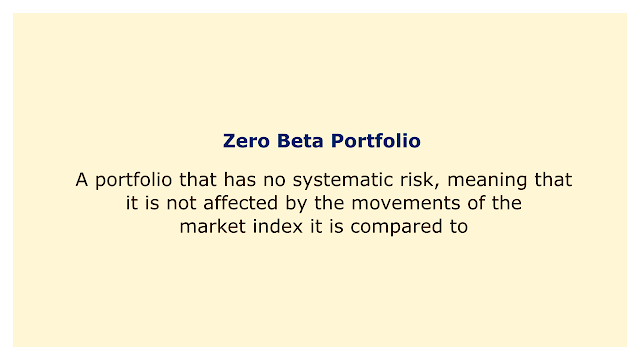 |
| Image: Moneybestpal.com |
A zero-beta portfolio is a portfolio that has no systematic risk, meaning that it is not affected by the movements of the market index it is compared. The projected return on a zero-beta portfolio would be equal to the risk-free rate, which is typically the interest rate on short-term government bonds.
How is a zero-beta portfolio built? You must choose investments with a variety of betas, which indicate how susceptible they are to market fluctuations. Beta may be zero, positive, or negative. An investment with a positive beta tends to move in the same direction as the market, whereas one with a negative beta tends to move in the other way. Zero beta indicates that there is absolutely no correlation between the investment and the market.
Investments with various betas must be combined so that their weighted average beta is zero in order to produce a portfolio with zero beta. For instance, if you have two stocks, one with a beta of 0.8 and the other with a beta of -0.2, you can build a zero-beta portfolio by allocating 80% of your funds to the first stock and 20% to the second one. The formula for calculating the weighted average beta of a portfolio is:
Portfolio Beta = (Weight of Stock 1 x Beta of Stock 1) + (Weight of Stock 2 x Beta of Stock 2) + ...
In this case, Portfolio Beta = (0.8 x 0.8) + (0.2 x -0.2) = 0.
As long as you are aware of their betas and weights, you can also use other investment kinds to build a zero-beta portfolio, such as bonds or commodities.
What are a zero-beta portfolio's benefits and drawbacks? The primary benefit is the elimination of systemic risk, which is the risk that influences all market assets as a result of variables like political upheaval, cyclical economic conditions, or natural calamities. You may lower your portfolio's volatility and protect yourself from losses during market downturns by removing systematic risk.
The biggest drawback is that it also takes away the chance to generate returns that are larger than the risk-free rate. You cannot profit from market upswings or seize any surplus returns from particular sectors or industries if you have no market exposure. However, building a zero-beta portfolio can be expensive and complicated because you must continuously review and tweak your investments to keep a zero-beta balance.
